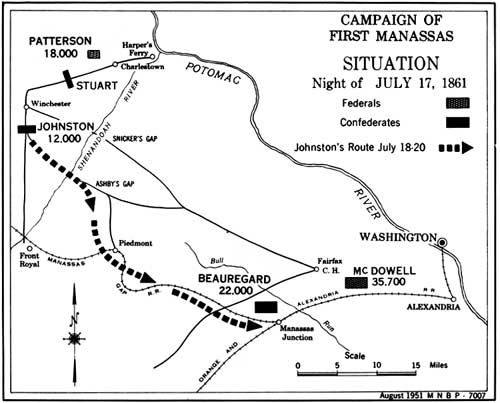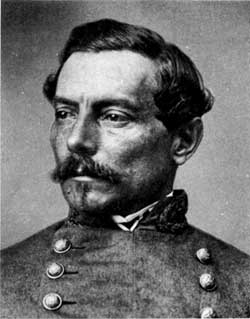|
MANASSAS National Battlefield Park |
 |

(click on map for a larger image)
Confederates Look to Manassas Defenses
On June 1, Brig. Gen. Pierre G. T. Beauregard, the Confederate hero of Fort Sumter, arrived to take command at Manassas. Two days later he was writing President Jefferson Davis requesting reinforcements. At this early date the defenses of Manassas appeared anything but formidable to the eyes of an English lieutenant of artillery who, arriving at night, viewed them for the first time: "I could scarcely believe that this was a great military depot, there being nothing within my range of vision to indicate that such was the fact. The station itself was a low, one-storied building, about seventy-five feet in length, with bales and boxes scattered about; a house of refreshment close by was uninviting, and except one or two small cottages scattered here and there, naught was to be seen."
 Brig. Gen. Pierre Gustave Toutant Beauregard in command of the Confederate Army of the Potomac. Courtesy National Archives. |
By the end of June this picture had materially changed. The roads, the fields, and the town were filled with soldiers by the thousands. Around the junction massive fortifications had been erected running out in different directions from the station. Through the embrasures of these earthworks the muzzles of heavy cannon pointed menacingly toward Washington. Acres of trees had been felled to give free range to artillery, and at key positions along the front men were constantly on guard at their battle stations. Camps had sprung up like mushrooms in the open countryside, and here troops in and our of uniform could be seen almost incessantly engaged in drill.
By June 23, Beauregard was able to advise the Confederate Secretary of War that, in consequence of large reinforcements lately received, he had been able to divide his forces into six brigades commanded by Bonham, Ewell, D. R. Jones, Terrett, Cocke, and Early. Advance detachments had been stationed at key points including Centreville, Fairfax Court House, Germantown, the junction of the Old Braddock Road with the Fairfax Court House Road, and at Sangster's Crossroads. With the main body of his troops partially intrenched along Bull Run, from Union Mills to the Stone Bridge, Beauregard watched closely the Federal preparations for an advance.
As the tension mounted, alarms occurred with increasing frequency. Bootless, hatless, and coatless men often dashed to assembly sounded by the "thump, thump of the big drums." Rumors of the Federal advance "filled every breeze." In a dispatch, dated July 9, Beauregard informed President Davis: "Enemy's force increasing, and advancing daily this side of Potomac. He will soon attack with very superior numbers. No time should be lost in re-enforcing me here with at least ten thousand men—volunteers or militia."
On the 17th Beauregard telegraphed President Davis informing him of an attack on his outposts and requesting that he send reinforcements "at the earliest possible moment." Confronted with this crisis, Davis acted quickly. Advising Beauregard of the dispatch of reinforcements of Hampton's Legion, McRae's regiment, and two battalions of Mississippi and Alabama troops, he ordered Holmes' troops up from Fredericksburg. The same day, through his adjutant, he sent the following dispatch to Johnston in Winchester:
RICHMOND, July 17, 1861.
General J. E. JOHNSTON, WINCHESTER, Va.:
General Beauregard is attacked. To strike the enemy a decisive blow a junction of all your effective force will be needed. If practicable, make the movement, sending your sick and baggage to Culpeper Court-House either by railroad or by Warrenton. In all the arrangements exercise your discretion,
S. COOPER,
Adjutant and Inspector General.
Realizing that Harper's Ferry was untenable, Johnston had previously retired upon Winchester, with Patterson in cautious pursuit. Receiving Davis' dispatch at 1 a. m., July 18, Johnston determined to elude Patterson and join Beauregard as quickly as possible. By a forced march he reached Piedmont where his various brigades entrained for Manassas Junction, 35 miles away. Brig. Gen. Thomas J. Jackson's brigade was in advance, followed by those of Bee, Barrow, and Elzey.
Thus, after approximately 3 months of hurried preparation following Sumter, the stage was finally set—the drama of the opening battle was about to unfold.

|

|
|
Last Modified: Sat, Apr 7 2001 10:00:00 am PDT |


